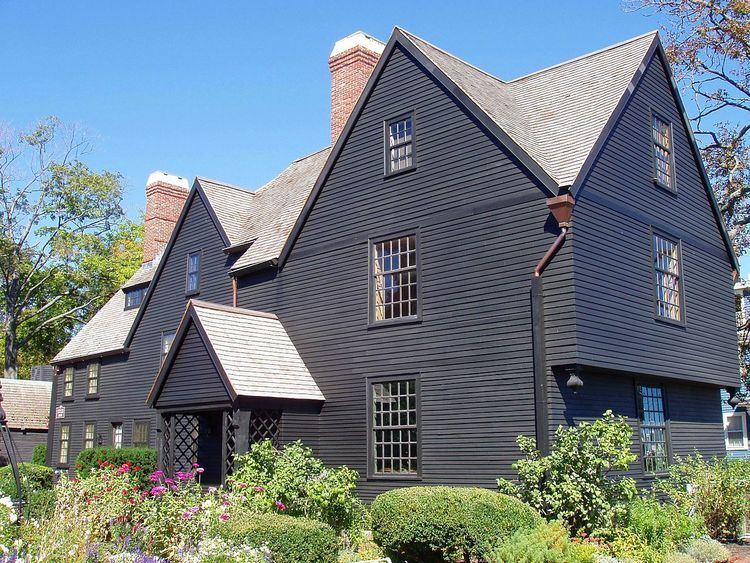Architect Multiple NRHP Reference # 73000323 Phone +1 978-744-0991 | Built 1667 Architectural style Colonial, Georgian Opened 1667 Added to NRHP 8 May 1973 | |
 | ||
Address 115 Derby St, Salem, MA 01970, USA Hours Open today · 10AM–5PMWednesday10AM–5PMThursday10AM–5PMFriday10AM–5PMSaturday10AM–5PMSunday10AM–5PMMonday10AM–5PMTuesday10AM–5PM Similar The Witch House, Salem Witch Museum, Witch Dungeon Museum, Count Orlok's Nightmar, Peabody Essex Museum Profiles | ||
The house of the seven gables full audiobook part 1 of 6
The House of the Seven Gables (also known as the Turner House or Turner-Ingersoll Mansion), made famous by American author Nathaniel Hawthorne's novel The House of the Seven Gables (1851), is a 1668 colonial mansion in Salem, Massachusetts, named for its gables. The house is now a non-profit museum, with an admission fee charged for tours, as well as an active settlement house with programs for children. It was built for Captain John Turner and stayed with the family for three generations.
Contents
The house
The earliest section of the House of the Seven Gables was built in 1667 for Capt. John Turner. It remained in his family for three generations, descending from John Turner II to John Turner III. Facing south towards Salem Harbor, it was originally a two-room, 2 1⁄2-story house with a projecting front porch and a massive central chimney. This portion now forms the middle of the house. Four windows of the original ground-floor room (which became a dining room) remain in the house's side wall.
A few years later, a kitchen lean-to and a new north kitchen ell to the rear of the house were added. By 1676, Turner had added a spacious south (front) extension with its own chimney, containing a parlor on the ground floor, with a large bed chamber above it. Ceilings in this new wing are higher than the very low ceilings in older parts of the house. The new wing featured double casement windows and an overhang with carved pendants; it was capped with a three-gabled garret.
In the first half of the 18th century, John Turner II remodeled the house in the new Georgian style, adding wood paneling and sash windows. These alterations are preserved, very early examples of Georgian decor. The House of the Seven Gables is one of the oldest surviving timber-framed mansion houses in continental North America, with 17 rooms and over 8,000 square feet (700 m2) including its large cellars.
After John Turner III lost the family fortune, the house was acquired by the Ingersolls, who remodeled it again. Gables were removed, porches replaced, and Georgian trim added. Their relative Nathaniel Hawthorne was occasionally entertained in the house by his cousin Susannah Ingersoll. By Hawthorne's time, the house had only three gables, but his cousin told him the house's history, and showed him beams and mortises in the attic indicating locations of former gables. Horace Ingersoll, Susanna's adopted son, told Hawthorne a story of Acadian lovers that later inspired Henry Wadsworth Longfellow's 1847 poem Evangeline.
Museum
In 1908, the house was purchased by Caroline O. Emmerton, founder of the House of Seven Gables Settlement Association, and she restored it from 1908 to 1910 as a museum whose admission fees would support the association. Boston architect Joseph Everett Chandler supervised the restoration, which among other alterations reconstructed missing gables. In some cases historical authenticity was sacrificed in the interest of appealing to visitors, who expected the house to match the one Hawthorne described in his romantic novel. Thus, for example, Emmerton added a "cent-shop" resembling that operated by the author's fictional character Hepzibah Pyncheon.
She also added what looks like a wood closet but has a false back. When opened, the back leads to a secret staircase which leads up to the attic.
Many interesting features of the original mansion remain, including unusual forms of wall insulation, original beams and rafters, and extensive Georgian paneling.
The Nathaniel Hawthorne Birthplace is now immediately adjacent to the House of the Seven Gables, and also covered by the admission fee. Although it is indeed the house in which Hawthorne was born and lived to the age of four, the house was sited a few blocks away on Union Street when he inhabited it.
On March 29, 2007, the House of the Seven Gables Historic District was designated a National Historic Landmark District.
